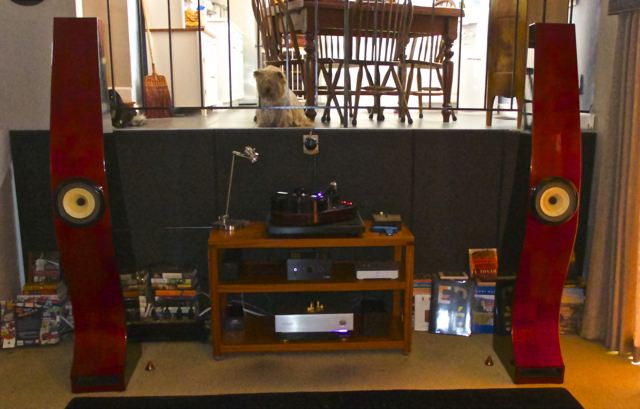
In July of this year, we published the review of the Linear Tube Audio MZ2-S amp in my digital system driving the little Teresonic Magus speakers so, I’m not going to go back over the introduction and technical description of the amp. If you didn’t read that review, just click here. I will remind you that this is a one-watt amp designed by David Berning. The Berning micro-ZOTL Personal Amplifier has been out of production since 2008. Then, along comes Mark Schneider, the founder of Linear Tube Audio, and with the approval of David Berning, an improved version is now back in production.
After a little over four months of enjoying the MZ2-S in my digital system, I finally made myself move it down to my reference system. I’m sorry it took so long to get it into this system. Between audio shows and finishing the addition to our house, I just hadn’t gotten around to it. So as soon as I returned from the Rocky Mountain show, I got serious about hearing it in my reference system.
My question was how would this little amp perform when powering my Teresonic Ingenium XRs? They are 103dB efficient and use a single Lowther DX-4 Silver with a six-foot ETQWT transmission line enclosure with Helmholtz resonators. And how would this amp sound with a world-class vinyl system consisting of an AMG V12 turntable, an AMG V12 Turbo tonearm, and a DS Audio Master1 Optical Phono Cartridge?
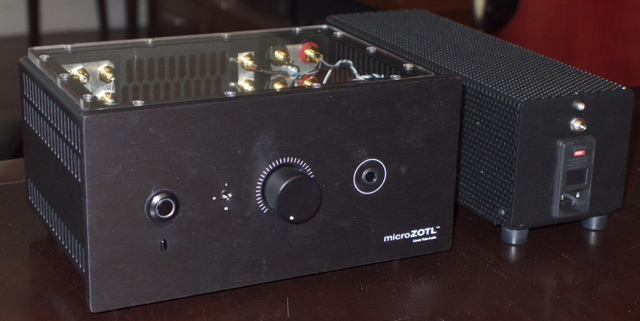
A Great One-Watt Amp
I have always heard that Paul Klipsch said, “What the world really needs is a great five-watt amp.” Well, it turns out, if you own a pair of 103 dB efficient speakers, what you really need is a great one-watt amp. I’ll be honest, as much as I liked the MZ2-S in my upstairs system, I really had no idea how good this little amp was until I put it in my reference system. When reviewing the original version of this amp Harvey “Dr. Gizmo” Rosenberg said of David Berning, “David Berning’s mind is a tube.” Maybe this explains the shockingly good sound I heard from the LTA MZ2-S amp. It was so good that it caught me very much off guard. It sounded so good and so different from my Pass Labs XA30.8 or the Wavac EC300B; the two amps I have lived with for so many years. Here is a quick list is the five ways that the LTA MZ2-S was different and better.
- It is much quieter (which I found hard to believe).
- It’s much more detailed in a natural and musical way.
- It provides an exceptional see-through quality into the layers of the music.
- The scale is very accurate regarding each instrument.
- The soundstage is very coherent, solid and huge.
The MZ2-S was so natural sounding that at first, I wasn’t sure what was going on, but in a few minutes, I quit worrying about what was going on and just enjoyed listening to music, glorious music. It was playing music in a way that hardly ever drew attention to the system itself. I’m not saying it sounded as good as a live performance, but I am saying that it seldom reminded me that I wasn’t listening live to people singing or playing instruments.
It all starts with the MZ2-S’s ability to do things I most often think amps just can’t do, especially tiny-output amps. It has the ability to be both incredibly dynamic and nimble at the same time. I don’t mean it is both dynamic and nimble; it has the ability to be very nimble while playing a very dynamic performance. It has every bit of the incredible sense of immediacy of any SET amp I have heard, but with more control and more extended frequency extremes.
Listening to Music
Music just seemed to float effortlessly in space without ever seeming forced or strained. The bass is rhythmic so that my system sounded very lifelike, but it didn’t add any extra warmth to the bass. Maybe the biggest surprise was its ability to portray tonal accuracy and purity with instruments and voices, and at the same time, it had the most detail, speed, and micro-dynamics of any amp I have ever heard in my system. I had come to believe that in order to get certain of these qualities in an amp, I had to sacrifice the others. This is not true with this amazing little amp.
To illustrate, I’m sitting here as I write, listening to a digital download of Mary Lou Lord singing 52 Vincent Black Lightning accompanied only by her guitar. That’s right, just her voice and a guitar, and it was recorded in the New York subway. Yet, it’s so explosive, so emotional, yet so natural and relaxed at the same time. I can feel the emotion of her voice, the power of the strings, the warmth of the guitar body, and most of all it compelled me to stop and listen. This is far from an audiophile recording, but it comes to life through the MZ2-S. What brings it to life are the subtle details, I can now hear her breathing and phrasing along with the rhythm of her guitar playing. Another thing I notice as I sit and listen to this live recording is that the longer she plays, the more often I hear the strings sound a little loose when she strums them really hard. By the way, if you don’t have this recording, get it.
I didn’t really plan this when I started writing this review, but as I’m writing I know this when I’ve just kept putting on one album after another. So, I’m going to talk about a few more albums than I normally do in a review. I hope you can forgive me for the rambling a little.
I brought the Anne Bisson Trio’s Four Seasons In Jazz, Live At Bernie’s and Lyn Stanley’s The Moonlight Sessions Volume Two LPs home from RMAF, so they were the first two I listened to. Well, I had never heard either of these LPs on my system before, but I knew right off that there was something very special going on with this amp in my system. Still, I had to ask myself how much of it had to do with one LP being a direct-to-disc and the other being the One-Step system for pressing vinyl.
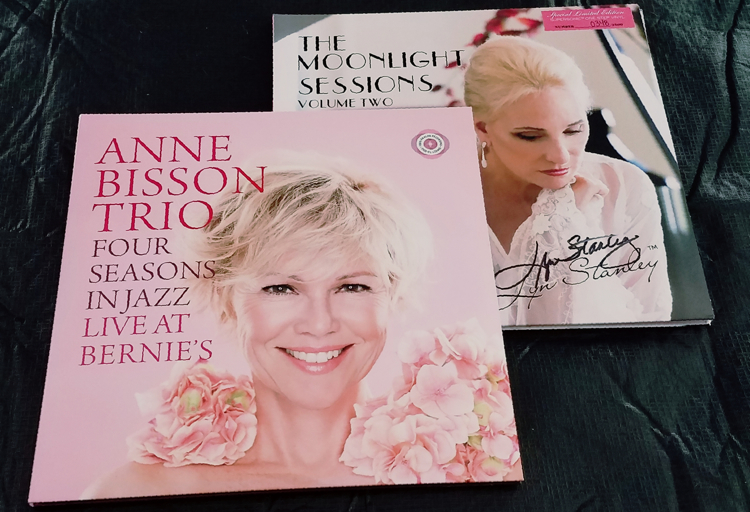
With it being a one-watt amp, I thought maybe I should also give it some real rocking music. So, I put on Neil Young and Crazy Horse’s Americana LP. I was even more amazed, I have listened to this LP many times and with many people, but I was not prepared for how much bigger the sound was, how much air there was, and the incredible dynamics and even more incredible micro-dynamics. It wasn’t just those things though; it had that scary alive sound that I remember from the Wavac EC300B and the controlled bass of the Pass Labs XA30.8.
The next LP I put on was Joan Baez’s Diamonds and Rust in the Bullring, this live recording really showed off this little amp. I loved hearing Joan Baez sing “Famous Blue Raincoat,” “Let It Be,” “Txoria Txori” and “Llego Con Tres Heridas.” Her voice was pure, and the music just flowed from note to note. Side 2 is all in Spanish and the crowd comes alive, and the backup singers are much stronger in their performance. All of this was much more obvious than ever before. This LTA amp is all about the music.
Then, I put one of Becky’s favorite LPs, Willie Nelson’s Stardust album on to play. With this little amp, I could hear the difference in textures and harmonics when Willie Nelson sings a song in contrast to some other singer singing it. I could hear and feel the difference in the emotions of a great ensemble playing a number. I was listening deep into the music; it’s layers, timbers, harmonics, and feelings. All of this is much easier with the MZ2-S in the system than any other amp I have ever had in my home. It allowed us to be brought deep into the emotions of Willie’s songs.
Ever since the movie Ray, I have been back into Ray Charles. I am so thankful for the original copies, both stereo and mono that I have of the 1961 Ray Charles and Betty Carter album. So I put the mono, my preference, on to give it a listen with the MZ2-S. It was rich-sounding, warm and mellow, which is appropriate for a recording of songs about love and romance. I love the way the horns and drums jumped right into the performance. With this amp, the horns have just the appropriate amount of bite, and when the piano comes in, it has just the right amount of warmth and reverb. Ray’s and Betty’s voices were tonally correct with no trace of exaggerated sibilance. Best of all, I just sat and listened to both sides of the LP.
I really like Gary Karr’s version of “Amazing Grace” on his album The Spiritual. The bowed strings of his bass blends so beautifully with Harmon Lewis playing the pipe organ. Karr’s bass sounded rich and full-bodied without any bloat, and I could hear and feel the deep pedal tones as Lewis played the big pipe organ there in Denmark.
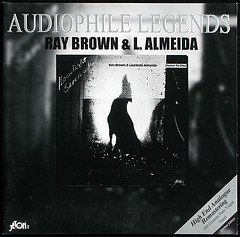
After listening to the Karr LP, I just really wanted to hear one of my go-to LPs. It is absolute proof that audiophile albums can have great music. It is in the Audiophile Legends collection, a direct-to-disc series done by Jeton in the eighties. This LP is entitled Ray Brown and L. Almeida. This was one of the most interesting recordings I listened to while reviewing the MZ2-S. I am so familiar with this recording and have played it for so many guests because of the unique blending of “Moonlight Sonata” played by Almeida on guitar and “Round ‘bout Midnight” played by Brown on the bass. I love this number.
Now, pay attention as this is a great example of choosing between audio artifacts and correct pitch and tonality. I have often pointed out to guests where near the end it sounds like Brown’s bass almost growls at you. The combination of this LTA amp with the Duelund and Audience wire is the first time I realized that it shouldn’t sound like a growl, but it should actually sound like the rich and very full way that Brown tuned his bass. Listening with the MZ2-S I hardly noticed his breathing or grunting but was drawn much more into the beautiful and rich, colorful tones of his bass and the incredible juxtaposition there was to Almeida’s guitar playing “Moonlight Sonata.” This was the moment that I realized this amp simply made music in my room better than I have ever heard before.
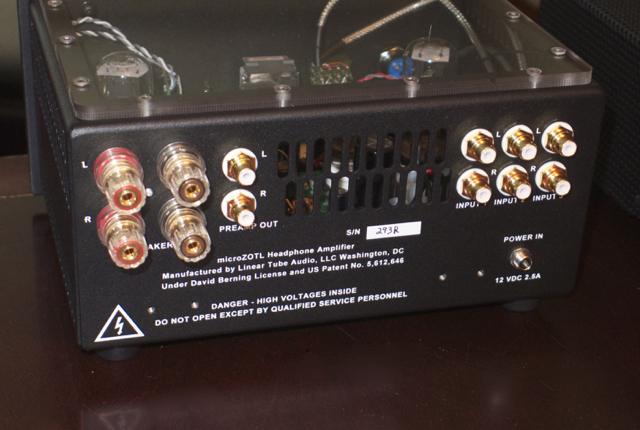
But What About Bass?
I think the fact that this amp only puts out one watt means we have to talk about how it plays bass. The first thing is that the bass goes much deeper than I had ever expected from this little amp. At the same time, the MZ2-S plays bass so that you can hear beautiful tonal colors, better pitch definition, and the air that follows the initial impact of the leading edge.
When I listened to drums, I could clearly hear the impact of the stick hitting the skin, the thunder of a big drum, and on good recordings, I could hear the air that moves with the mighty strikes of big drums. When listening to stand-up basses and cellos, I want to be able to hear the beauty of the strings and the sound of the wood bodies of the instruments with air moving about in them, which is something very special that I get from this amp every bit as well as with the $30,000 Wavac SET. When there is real bass on a recording, it’s actually startling. It’s so much fun to play a couple of LP’s that have no deep bass and then play one with real bass for people who have not heard this amp; it’s a jaw-dropping experience. This does lead to what a few people may not like since it does not add warmth to thin-sounding recordings. I’m willing to live with this to get the incredible bass I hear on most recordings.
Moving on to the crucial mid-bass and lower midrange, it is the frequency range that I feel most influences whether a system sounds like music or like a great audio system. Of course, it is also possible for this frequency range to make a system sound just plain muddy and thick. Still, too often I hear systems that cost in the six figures that do everything that is expected from a high-end system except sound much like live music. Let’s be honest, this fast, detailed bass and mid-bass is the exact sound that many people are looking for, and it draws me into the musical performance. The slightly thin mid-bass and lower midrange also add to the sense of depth in the soundstage that is so important to many people. Still, when I hear live music, this range is seldom thin or overly fast. It is more often full and rich sounding.
Importance of Cables
Getting this amp to excel in this area leads me to discuss cables and the MZ2-S amp. I started the review with the best cables I have ever heard on most systems, the High Fidelity Cables CT-1 Ultimate Reference magnetic cables. With every amp I have had over the last few years these cables were simply the best, but at quite a price. With the MZ2-S the mid-bass, upper bass, and lower midrange were slightly thin, not bad, but not as rich as I would like. So, I tried some different cables and came upon a magical combination. I removed all of the magnetic cables from the system including the power cables and replaced them with Audience AU24SX cables, except for the speaker cables where I used Duelund 12GA speaker cables.
With these changes, the MZ2-S produces a purity of sound in the upper bass and lower mid’s that I have never heard from recorded music. It allows plucked strings, drum strikes, and other upper bass transients to be startlingly alive, and I do mean startlingly. The comments on all but the first two albums above were based on this combination.
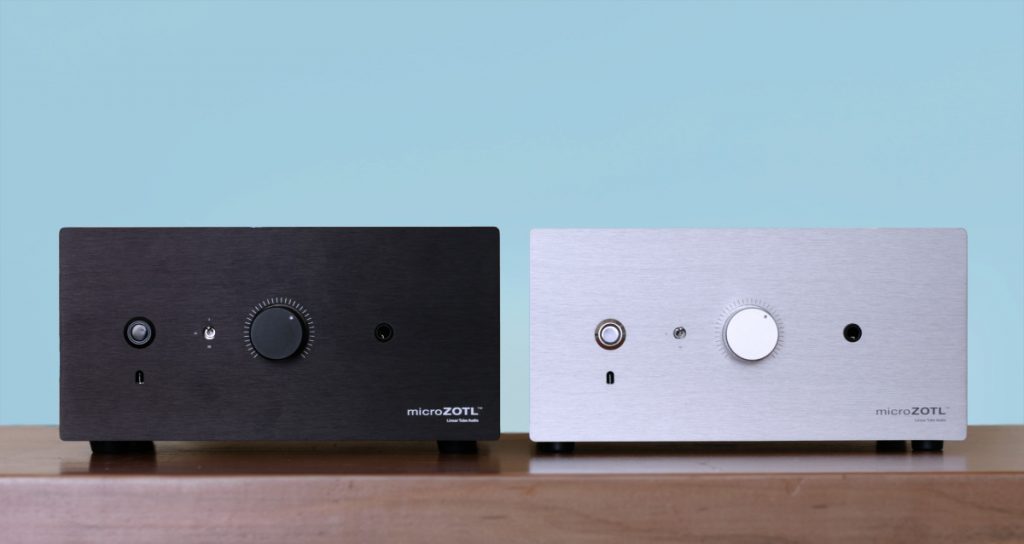
Imperfections
So far from reading this review, you would think that I think this is the best amp in the world. It’s not, but it’s the best I have ever heard on the Teresonic Ingenium XRs. Still, let me point out a few problems with this amp. The first one is obvious; it only puts out one watt which means there are very view music lovers who can take advantage of this great little amp. Second, it is very revealing of other things in your system, so you need to be sure your system is up to the quality this amp deserves to come into its own. Other than these two complaints, I can’t imagine a better amp if you have speakers that can be comfortable playing with one watt.
Concluding Thoughts
The late and in my and many others’ opinion the great Harvey “Dr. Gizmo” Rosenberg reviewed the original Berning microZOLT amp and used an old expression, to sum up the amp when he reminded us, “It’s not the size of the dog in the fight, but the size of the fight in the dog!” He went on as only Dr. Gizmo would put it to say, “Now stop, and print out these pages and take them into the potty, sit down and study. Study hard, because what I am describing is one of those rare and sublime work of audio arts that has the possibility of transcending the transcendent.”
Now in case you are wondering if the original was somehow better, on David Berning’s website he says of the new LTA version of his amp, “It’s back. And more remarkable than ever.” So I think it’s fair to apply Dr. Gizmo’s quotes to this amp, and I think they just about sum up this Great Little Amp! So let me conclude by thanking two men who just had to build a one-watt amp because it had to be done and not because there was really a market for it. Thank you, David, for designing it, building it, and letting Mark build it again. Thank you, both for the best amp I’ve ever heard in my reference system.
Addendum
I have not written much about the Teresonic Ingenium XR speakers. Because of the cost of the cabinet and the Lowther drivers, the Ingeniums now sell for $20,000. Still, at the cost of $22,000 for speakers and amp and preamp, I got a whole lot more music in my home than I have had in my room with $30,000 amps and $40,000 preamps and the Ingenium XRs.
SPECIFICATIONS MZ2-S
Price: $2,100
Amplifier class: Push-pull Class A, no feedback
Sensitivity: 0.6V RMS [full output]
Output impedance: (measured @ 0.5A, 60 Hz) 2 ohms
Input impedance: 50k
Power Supply Input: Auto-switching 100V / 120V / 220 / 240V operation or linear supply user-switchable between 110/120 and 220/240 (contact LTA if in need of a 100V linear supply)
Power Supply Output: 12VDC 2.5 amps
Hum and noise: minimum 60mV RMS or 90dB below full output (20Hz-20kHz)
Power consumption from ac power source: 33W
Power output: with 4-ohm load: 1W, 1% THD, with 14-ohm load: 0.5W, 1% THD
Channel separation: (4-ohm loads) 46dB, 100Hz-10kHz, (14-ohm loads): 54 dB, 100Hz-10kHz
Frequency response full power: (4-ohm load) +0, -1dB 10Hz-20kHz, (14-ohm load): +0, -1dB 5Hz-50kHz,
Voltage gain: (4-ohm load): 10.3dB, (14-ohm load): 12.4dB
Size: amp: 9 1/2 inches (24.1 cm)wide, 4 3/4 inches (12.0 cm) tall, 7 7/8 inches (19.7 cm) deep (including connectors); linear power supply: 12″ (30.48 cm) x 3.25″ (8.26 cm) x 4.25″ (10.8 cm)
Net weight: with switching supply: 5.35 lbs (2.5 kg) – amplifier and external power supply); with linear supply: 8.94 lbs (4.1 kg) – amplifier and external power supply)
Finish: Aluminum case w/ lexan top
Tube complement per channel: 12AT7/6201 input, 6SN7 or 12SN7 output
Specifications for Teresonic Ingeniums XR Speakers
Price: $19,985
Description: One-way floor standing dynamic loudspeaker
Enclosure type: ETQWT™ transmission line with Helmholtz resonators
Drive unit: One 8” Lowther DX4 driver with Silver coils
Bandwidth: 30Hz-22kHz ± 3dB
Sensitivity: 103 dB @ 1W/1kHz/1m
Impedance: 8 Ohms
Crossover: None
Power handling: Power handling 1 – 100 Watts into 8 Ohms
Connectors: WBT, 24ct gold plated terminals
Internal wiring: Fully shielded Clarison cables
Dimensions: H x W x D : 73 x 10.3 x 20in (185 x 26 x 51cm)
![]()
